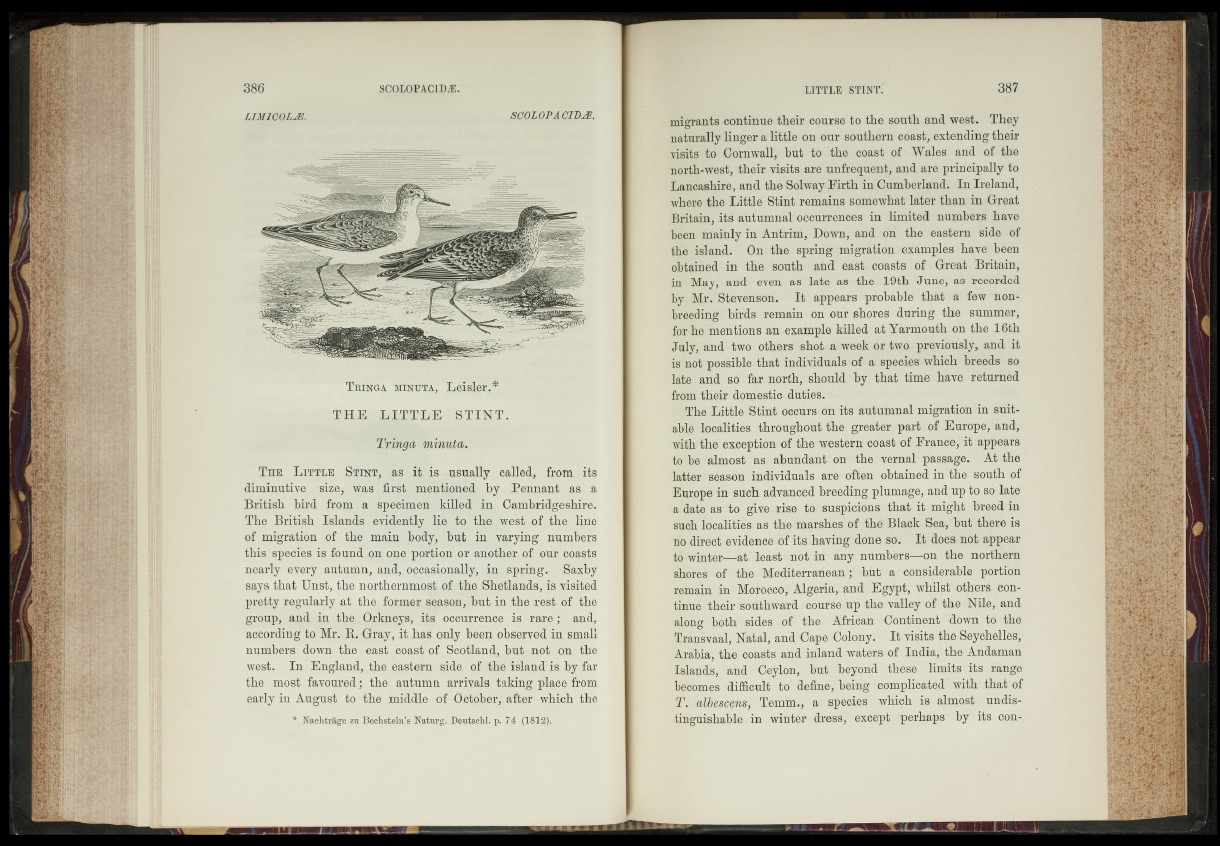
LIM1C0LJE. SCOLOPACIDJ.
* Tringa "minuta, Leisler.*
TH E L I TT L »IfcfB TINT/
Tr-inga %imuta.
The Little Stint, as it’ ;is -usually called, from its
diminutivejsiae, was first mentioned- by Pennant as a
British bird from a specimen 'killed in Cambridgeshire.
The British Islands evidently; il^Sto „-t^|%est of- the . line
of migration ,p£ the main body, but in varying^ numbers
this specie§. iffifound on one portion or another of our-gojrqts
nearly every autumn, and, qcc^ffiQM jfe .in .spring^ . Saxby
| a p . J J n g t , the nortkernmpgtpf, th j^hejlands, is visited
pretty regularly at tha. fmmg^ season, but in the rest of the
.group, and in the^Orlgueys, its’.pccurrencq is r a r e ; and,
according to Mr. B. Gray, it has qnly been observed in small
numbers down the > east coast of Scotland, but not on the
west. In England, tlie„eastern sidg|||fythe -island'i^.by far
the most favoured; the autumn arri^a^'taking-place from
early in August to the middle of ©ctobej?, after which the
* Nachtr&ge zu Naturg. Bei^tsctil. p. 74 %
migrants continue their course, to the south and west. They
naturally linger a little on our southern coast, extending their
visits to Cornwall, but to the coast of Wales and of the
north-west, their visits are unfrequent, and are principally to
Lancashire, and the Solway Firth in Cumberland. In Iréland,
where the L ittle Stint remains somewhat later than in Great
Britain, its autumnal occurrences in limited numbers have
been mainly in Antrim, Down, and on the eastern ' side of
the island. " O n the spring migrktion* examples. have been
obtained in the south and" east coasts of Great Britain,
in" May, and even as late as the 1.9th June, as recorded
by Mr. Stevenson; I t appears ’ probable th a t a few nonbreeding
birds'remain on our shores during the summer,
for- he’meh tinns an example killed at Yarmouth on the .16th
July, and two others' ghat a week or two previously, and it
is:hot 'passible th a t individuals-of- a species which breeds-so
late and so‘ far north, should by that time have returnéd
from their domestic duties.
réfhe Little Stint' occurs on its autumnal migration'in suitable
localities throughout the greater -part of Europe, and,
with the exception of the western’.coast of France;?it appears
tö> be%lmostr’ as abundant on -the vernal passage. "At the
latter séasón individuals are often obtained in A e -south of.
Europe in such advanced breeding plumage, and-tp4hgp late
a date*' as to give rise to suspicions that it might breed in
such localities a‘s the marshes of the Black- Sea, but there is
notdirect evidence&Sf its having done so. It does not appear
tmwinter—at Lteast .'not in any numbers—on the northern
shores of -tEe Mediterranean"; but': a/'considerable' portion
remain in Morocco, Algeria, and Egypt,; whilst othersycm^'
tinue their southwardAfeiirse up the valley of* the Nile, and
along both' side's -tóf’ the African Continent döwn .tó th&.'
'Transvaal, Natal, and Cape-Colony:^ Itmsits the Seychelles;
Arabia', thé coasts and inland waters of India, the Andaman
Islands, and f Ceylon, but 'beyond . ttesêL limits-dts range
Hornes difficult to" define, ’being complicated~ with that of
T. -albescepsf' Témm., a < species which-As almost undis-
tinguishablh| in winter - dress, except perhaps by its con